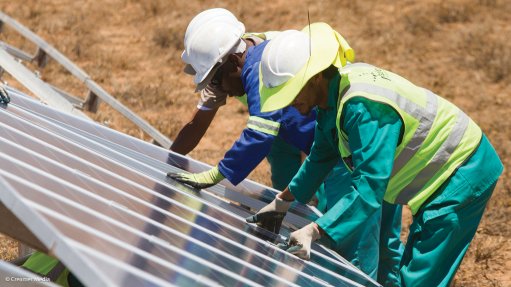
Solar photovoltaic installations surged by 32.2%, or 346 GW, last year
Photo by: Creamer Media
Despite record renewable-energy installations of 473 GW last year, the International Renewable Energy Agency (Irena) says the pace of deployment remains well below that needed to match the global goal of tripling capacity by 2030. In addition, the geographic distribution of new investment was highly uneven, with Africa lagging in particular.
The ‘Renewable Capacity Statistics 2024’ report states that the installed renewables base climbed 13.9% to 3 870 GW in 2023, underpinned by solar photovoltaic (PV) installations, which surged by 32.2%, or 346 GW.
Together with wind, solar PV accounted for 98% of the new renewables capacity installed last year, with hydro accounting for the bulk of the balance.
“This growth in wind and solar led to the highest annual increase in renewable generating capacity as well as the highest growth on record in percentage terms,” Irena said, adding that renewables accounted for 86% of all capacity additions last year.
Renewables’ share of total power capacity also rose by almost three percentage points from 40.4% in 2022 to 43.2% in 2023.
A total of 326 GW, or 69%, of the new renewables capacity was added in Asia, underpinned by China, whose capacity increased by 63% to reach 297.6 GW.
All other regions also experienced growth, with Europe and North America installing 71.2 GW and 34.9 GW apiece, with growth rates of 10% and 7% respectively.
Africa also continued to grow, by at a more modest pace of 4.6%, adding 2.7 GW last year, reflecting what Irena director-general Francesco La Camera described as a “decarbonisation divide”.
Irena also stressed that far more still needs to be done to achieve the goal adopted at COP28 to triple installed renewable power capacity by 2030 to reach 11 TW.
“Policy interventions and a global course-correction are urgently needed to effectively overcome structural barriers and create local value in emerging market and developing economies, many of which are still left behind in this progress.
“The patterns of concentration in both geography and technology threaten to intensify the decarbonisation divide and pose a significant risk to achieving the tripling target,” La Camera said.